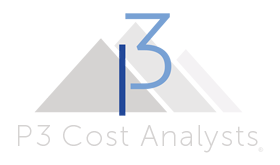Telecom Expense Audits
Our Customers Save An Average Of 15-30% On Telecom Overcharges.
Save on Local, Long Distance, Wireless, Data, Internet & More


At P3 Cost Analysts, we are experts in deciphering the telephone billing maze. We partner with you to reduce or remove unnecessary charges and fees, evaluate your current billing platforms compared to market pricing/trends, and obtain refunds due to billing errors through telecom auditing that drain your bottom line. Our telecom expense audit allows your company to:
- Avoid dedicating valuable resources and money trying to deal with the telephone companies
- Educate your employees on telephone tariffs, rates, discounts, promotions, and USOC codes
- Negotiate new services or contracts
Our Clients Have Saved Millions


![]()
![]()
"Their experience and expertise has saved us thousands and thousands in a short period of time"
Eric V
Property Manager


![]()
![]()
"I candidly have never witnessed a relationship that was this easy and this beneficial for both parties"
Greg R
Quick Serve Restaurants


![]()
![]()
"P3 is a company that is reliably showing us value. They are such a pleasure to work with.”
Storm N
Hotel Group
-




"Their experience and expertise has saved us thousands and thousands in a short period of time"
Eric V
Property Manager -




"I candidly have never witnessed a relationship that was this easy and this beneficial for both parties."
Greg RQuick Serve Restuarants
-




"P3 is a company that is reliably showing us value. They are such a pleasure to work with."
S NolanHotel Group
Complete Expense Auditing Services
Your expenses don't stop at telecom and neither do your potential savings. Our Expense Audit will help you truly understand how your money is spent and where savings are available. In many cases, we can even get your company a refund for past overages.Take Advantage of Third Party Telecom Auditing
Partnering with P3 means access to our tens of thousands of data points and benchmarks. We use this data, combined with our analysts' expertise, to drive savings for your company. Using this data along with our telecom audit, ensures no stone is left unturned. You will know with certainty, that there is no money left on the table after our audit. Plus should you decide to work with us long term, post audit, you will also enjoy the convenience by referring sales people, quotes and billing questions to us to handle, meaning you have more time to focus on your core business.
Telecommunication Management Services
Services offered by P3 Cost Analysts through its Telecommunication Management Services (TMS) for your company are designed to maximize your profit and minimize your time. Below is a list of what we can offer you:
- Telecom audits for all local, long distance, wireless, data and Internet
- An evaluation of the cost effectiveness of line charges, usage charges, and feature packages
- A detailed report containing all errors and overcharges, with an explanation of areas of cost savings
- Constant monitoring of current changes occurring in all areas of the telephone industry for opportunities to lower monthly costs, consolidate services, and remove redundant or outdated charges
P3 Telecom Auditing:
The Ultimate Guide to Reducing Your Telecom Services Costs
Reducing Your Telecom Services Costs


Reducing costs for telecom services is quite difficult for the average customer.
Between a lack of transparency around telecom billing tactics, and vendors frequently not billing according to their own contracts, customers tend to overpay for these services without knowing it.
To find errors, overcharges, and breaches of contract, it takes a high level of knowledge and me that a typical customer doesn’t have. Ultimately, it takes a thorough audit by telecom industry experts to truly start cutting costs in this expense category.
Let’s take a closer look at the telecom industry, why there are savings to be found, and how P3 Cost Analysts bring
to our customers.
Telecom Industry Overview and Pricing


Though telecom is an open market, vendors must still outline tariffs that exist as an agreement between themselves, regulating bodies, and customers as to how much they charge for their services. Vendors are no longer required to file their tariffs with the FCC, but many still choose to do so. Others file them with state-level utility commissions and also publish them on their websites.
While there is regulator on in the telecom industry via the Federal Communications Commission, vendors tend to keep their billing tactics as secret as possible. They don’t want customers questioning their bills and therefore don’t release certain billing information unless a customer specifically calls in and requests it. The issue is, even if a customer requests more details about their bill, they o en won’t be able to understand the complex language or figure out if they are actually being overcharged.
Another issue is that customers simply don’t know what they don’t know. They think their IT or billing department is checking to make sure they are getting the best price, but these in-house employees rarely have the knowledge and industry expertise required to optimize spending on telecom services. Their expert se lies in keeping the technology running, rather than figuring out if they are being billed accurately and at the most efficient cost.
Why There Are Savings and How P3 Cost Analysts Bring Them to Clients
Below are the key areas of telecom billing that P3 Cost Analysts audits in order to discover errors, overcharges, and other areas of dispute.
Customer Service Records
A customer service record is a very detailed report of what telecom services a customer uses, what rates they’re charged at, and how these rates are calculated. Anyone can request these records but many customers don’t even know they exist. Even if a customer does request these records, they won’t be able to understand them because they are written in a computer-generated code that only a trained expert would understand. It would even be difficult for a finance director or CFO to understand these documents.
Here’s an example of what a portion of a CSR looks like:


At P3 we have trained experts who know how to read these documents and find errors or overcharges. Within these customer service records we look for:
- Unused lines that the customer is still being charged for: Once we know which lines a customer is being charged for, we work through a comprehensive line verification on process where we call all lines and document which ones are actually active.
- Extra telecom service features that aren’t being used: These can include features such as call forwarding, call waiting, and automatic redial. For example, we’ve seen customers being charged for call waiting on elevator or emergency lines, which obviously don’t need this feature.
- Bill padding: Vendors will tack on fees for things such as unneeded tech support or wire maintenance.
- Rates on long-distance calls that are above industry benchmarks: In most cases, the long-distance minutes a customer uses aren’t on their bill, and even if the customer is able to figure out these minutes and charges, they won’t know if they are getting a good deal. We are able to cross-reference a customer’s rate with industry benchmarks to verify the quality of a customer’s rate.
- Misapplied surcharges, taxes, tariffs, and other fees.
Vendor Tariffs
Another key way in which we find savings is by comparing the customer service records described above with a vendor's outlined tariffs to make sure the vendor is actually following their pricing guidelines.
For the average customer, finding these tariffs can be difficult. Luckily, at P3 we know how to access these documents in order to compare them to a customer’s CSR.
In some cases, vendors aren’t following their pricing guidelines and at other times they’re simply misapplying tariffs. Both of which we can verify and correct if needed.
Contracts
You would be amazed by how many telecom vendors don’t bill according to their contracts. In many cases, discrepancies with contracts revolve around discounts not being applied to the customer’s account properly.
Here are some examples:
- The vendor may outline a discount in the contract but the customer is unaware of it, or it’s hidden within a lengthy document. Therefore the vendor doesn’t actually apply the discount.
- There can be typing errors leading to a customer not getting their full discount. For example, the customer is supposed to get an 80% discount but they’re getting billed at an 8% discount.
- Vendors say the discount will show up in a month or two, but the customer forgets about it and doesn’t receive the discount.
P3 can also help clients enroll in new contracts. Some times a client’s contract has expired and they fall under casual rates without knowing it. These rates are much much higher than contract rates and we help customers get back into a fair contract as quickly as possible.
Terms and Conditions:


The key reason we audit terms and conditions is to find out how far back we can look for disputes and what kind of credits can be reapplied to a client’s account. In a lot of cases, when we open a dispute from a while ago, the vendor will just try to issue a customary three- to six-month credit instead of the full amount. We’ve been in the industry long enough to know that we don’t have to accept this offer.
We are able to understand the language outlined in the terms and conditions in order to bring our clients the refund they deserve based on when the actual error occurred. Vendors typically comply with our requests so that the FCC doesn’t need to get involved, but there have been rare instances where we have taken a dispute to the FCC.
The P3 Telecom Services Auditing Process
![]()
![]()
After the execution of our shared savings agreement, we gather customer service records, pull tariffs, and request contracts from the telecom companies. In most cases, gathering this info can take 5–10 days, or even up to a month with some vendors.
![]()
![]()
During the audit phase, we apply decades of expertise in this industry to review and compare contracts, customer service records, and tariffs, searching for errors and overcharges. We also run all client expenses against our database of vendor benchmarks to be sure our clients have best-in-class pricing.
![]()
![]()
About 4–6 weeks after our initial meeting, we come back to the client with our findings and recommendations in a savings letter. The client can then authorize us to move forward with negotiating with the telecom vendors.
![]()
![]()
Once our findings are approved, we work with the vendor to secure new agreements, resolve disputes, and set up the most cost-efficient telecom programs.
![]()
![]()
Once negotiations are complete, we implement our recommendations and then share in the cost savings with our clients.
![]()
![]()
During this phase, we monitor our client's invoices each month to ensure that savings stay intact and vendors honor their agreements and pricing. We have found vendors are constantly violating their own agreements and we monitor and fight off unwarranted price increases and overcharges on our client's behalf. Furthermore, we monitor market conditions and look for ways to keep costs down or drive them lower.
Average Savings on Telecom Services:
P3 averages finding clients savings of 15-30% on their telecom expenses. Below are some examples of work we’ve done for our clients.
Case Studies
School System - $150,000 refund + $3,000/month in savings
With this particular school system, the client was paying great rates for all of their telecom services. Most other aspects of the audit confirmed that there were no overcharges or opportunities for savings. However, the client did have a PRI that was being billed incorrectly. They also had associated taxes and fees that were being overbilled. The vendor had simply misentered the allowable charges (per the tariff) on the client’s account. It had been billed in error for 14 years. We identified this error and began working to have it fixed by the vendor. Countless employees at the vendor would not acknowledge this was indeed an error. They did not understand their own tariff and believed it to be billed correctly. After finally finding someone at the vendor who agreed it was an error, they offered a 3-month refund of the overcharge, claiming that was all they were legally required to refund. We knew this was not true.
We knew with this particular type of error the client should have it refunded back to the point of error.
After many more calls with the vendor, and even seeing this escalated up to the CFO of the vendor company, our client received a $150,000 refund check in the mail and saw their bill reduced by over $3,000/month.
Government Entity - $5,100/month in savings
A city was charged for about 50 business lines on a consolidated bill and individual contracts and the business lines were not under contract with a particular vendor. As a result, the city was charged very high rates for the business lines. P3 Cost Analysts worked with the telecom vendor to negotiate lower rates for the business lines. Once the business lines were placed under contract, P3 Cost Analysts were able to reduce the charges by $5,100 per month.
Hazardous Waste Disposal Company - $1,000/month in savings
The wireless accounts for a company were not receiving any discounts. P3 Cost Analysts negotiated with the wireless carrier and applied discounts to the wireless accounts. By adding the discounts, P3 Cost Analysts were able to reduce the client’s bill by $1,000 per month.
If you’re interested in having P3 Cost Analysts take a look at your telecom bills and see what our auditors can uncover, reach out to us on our website, by filling out our contact form, or calling 1-877-843-7579, and we’ll be in touch.


